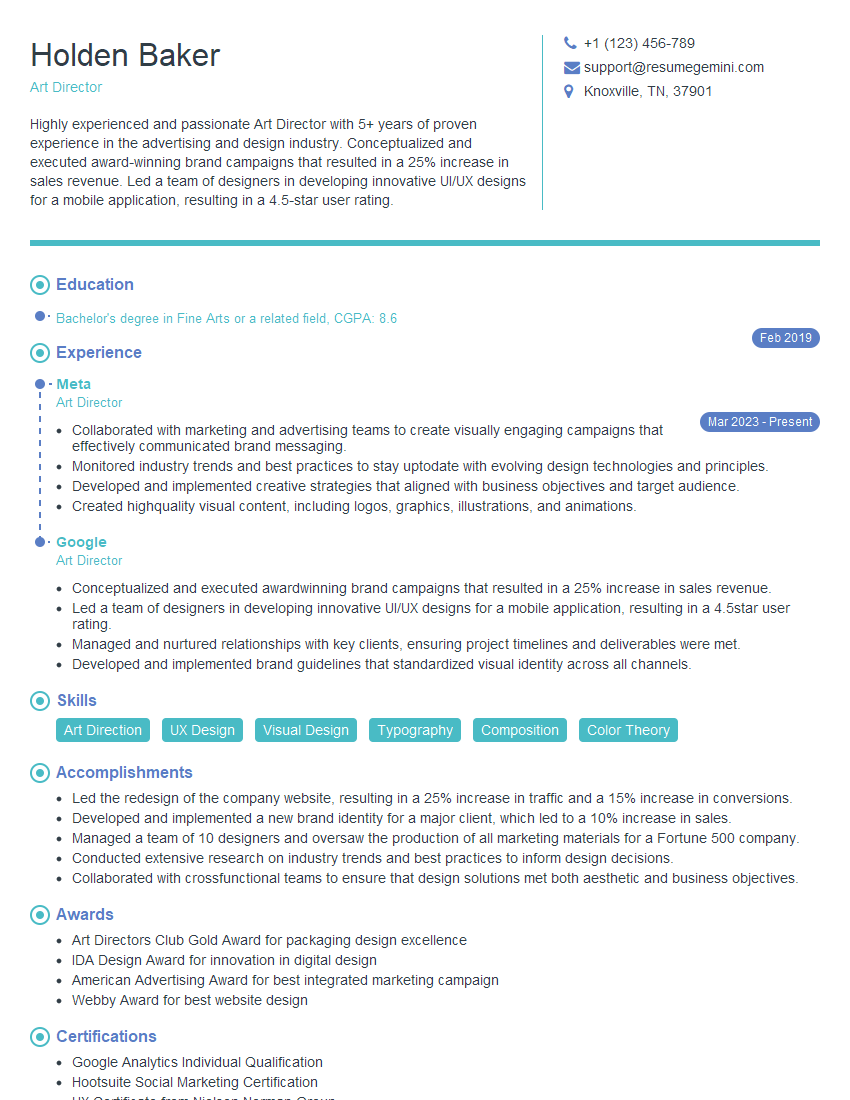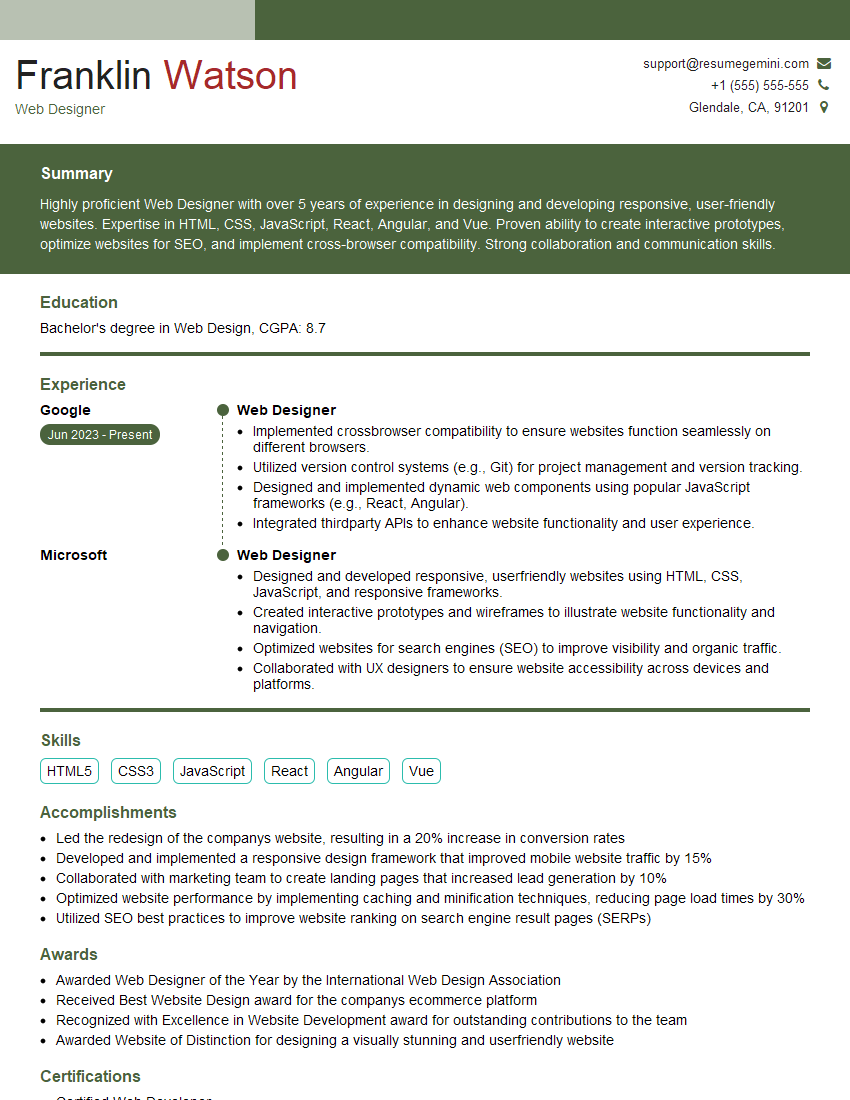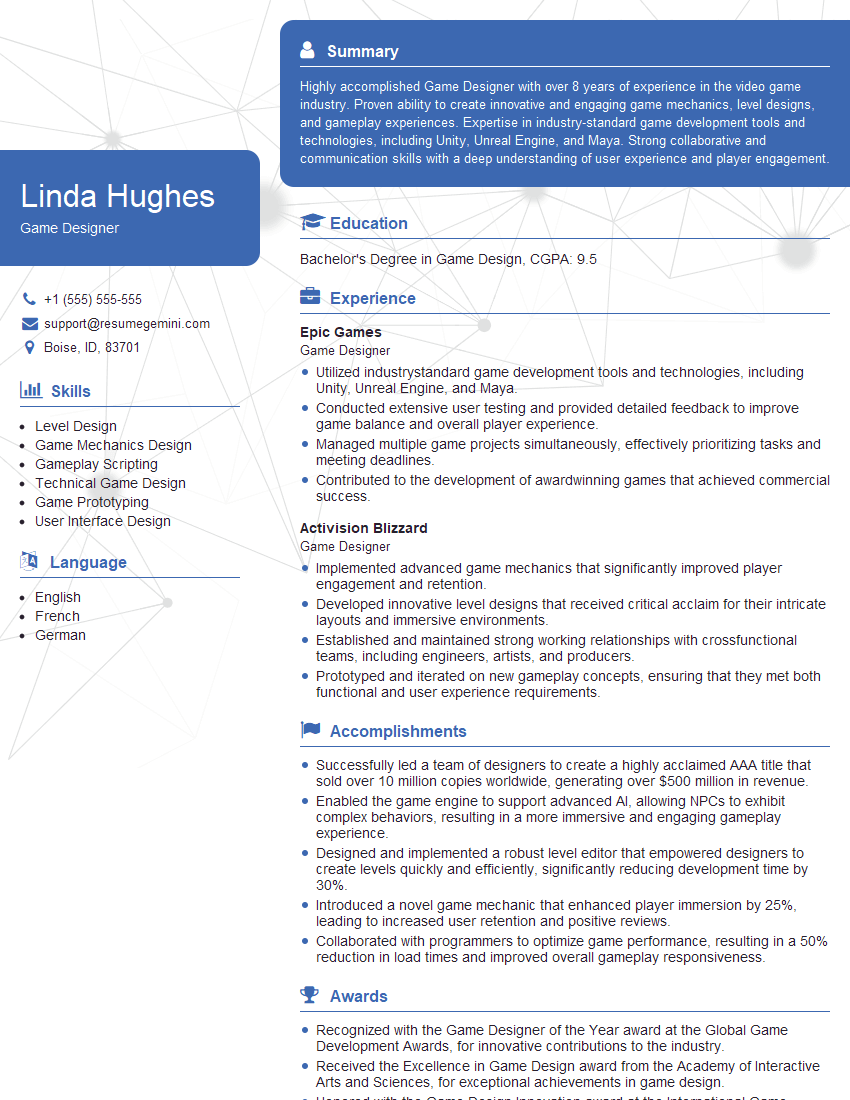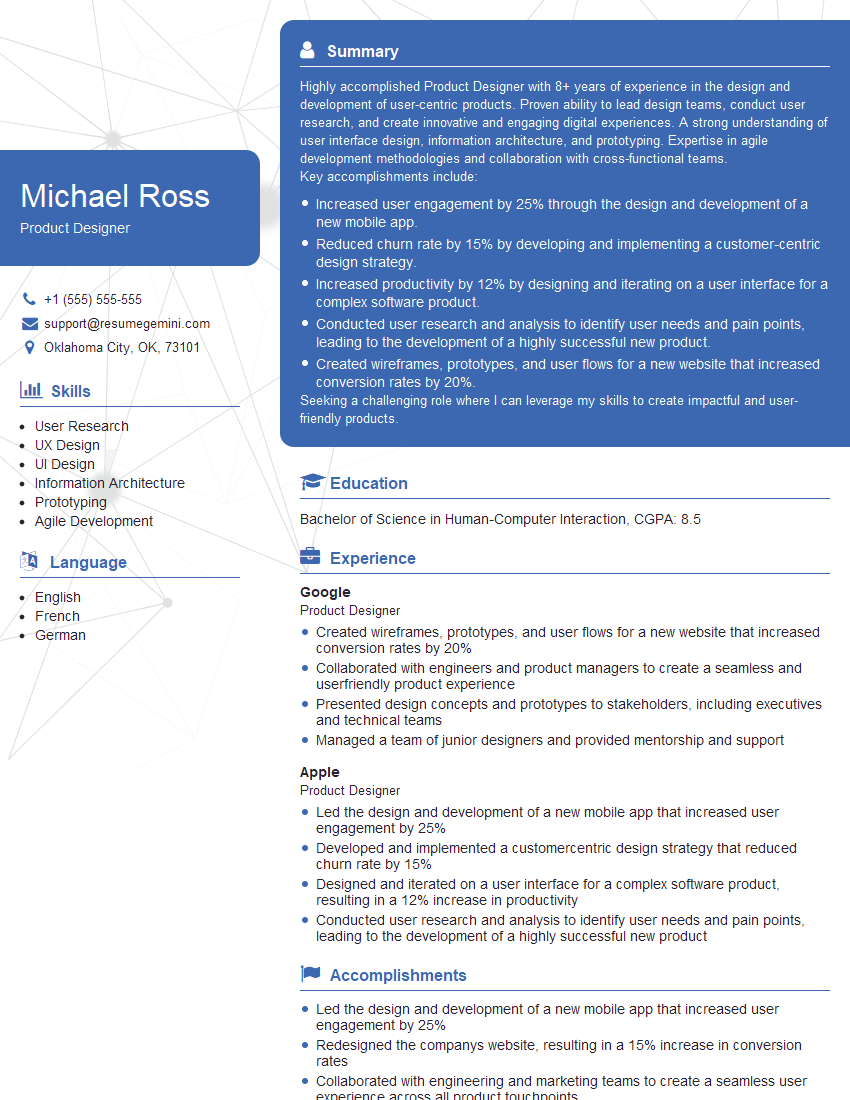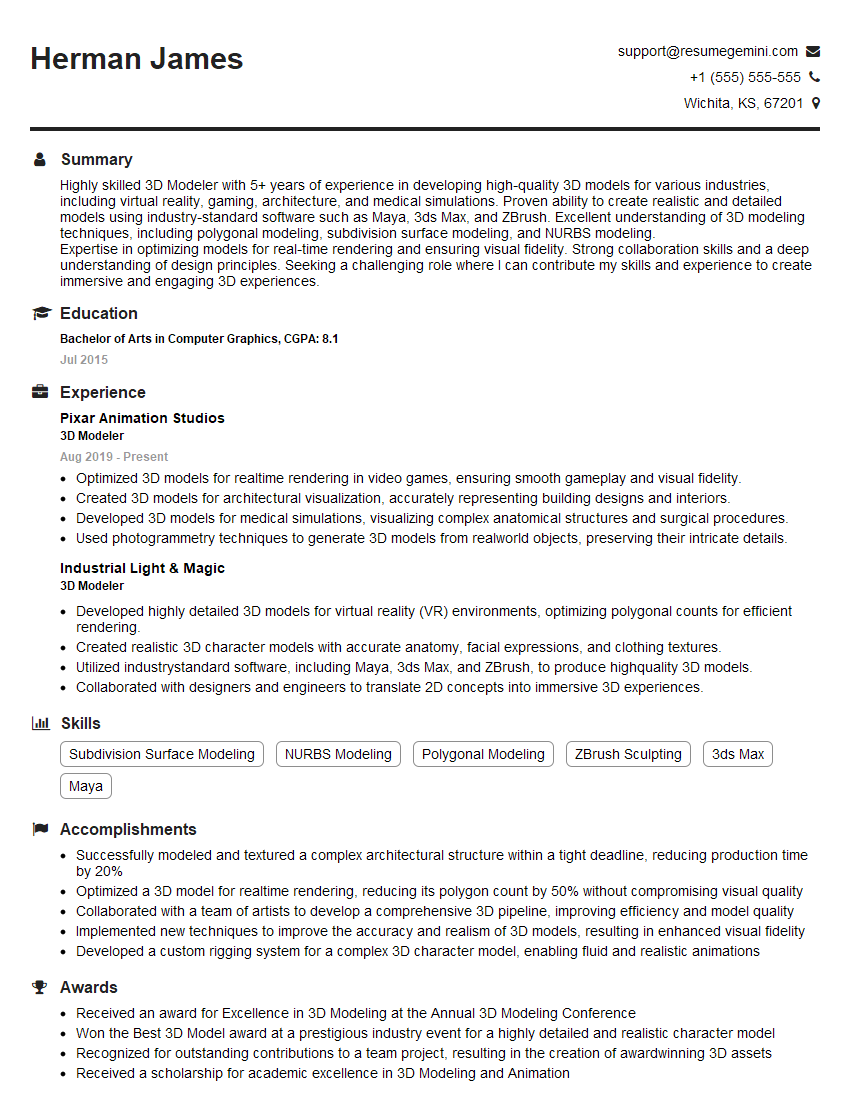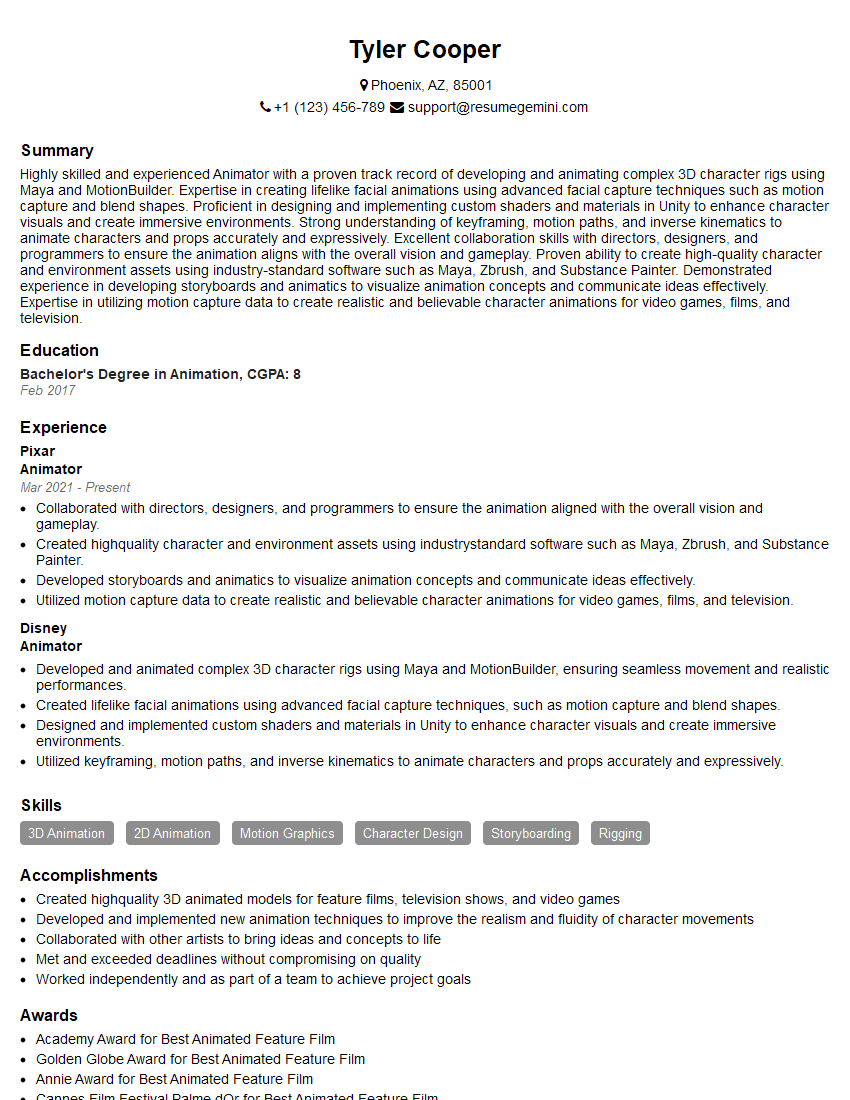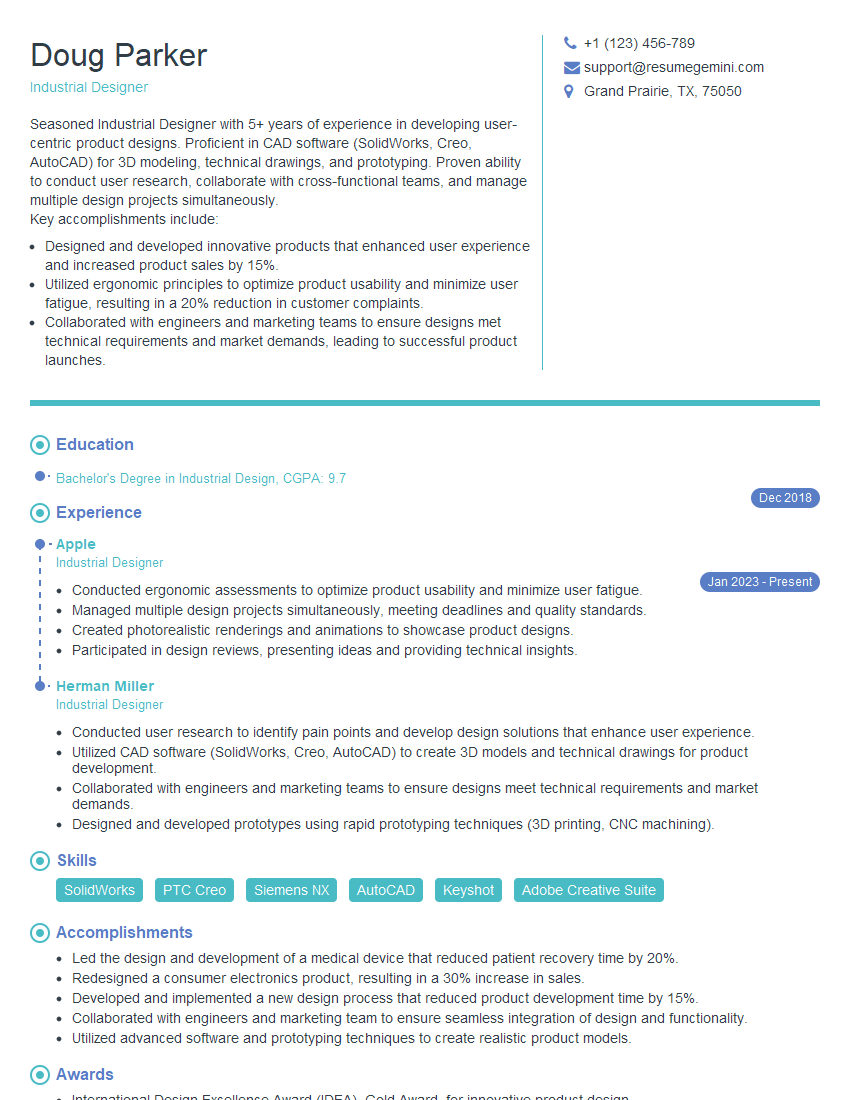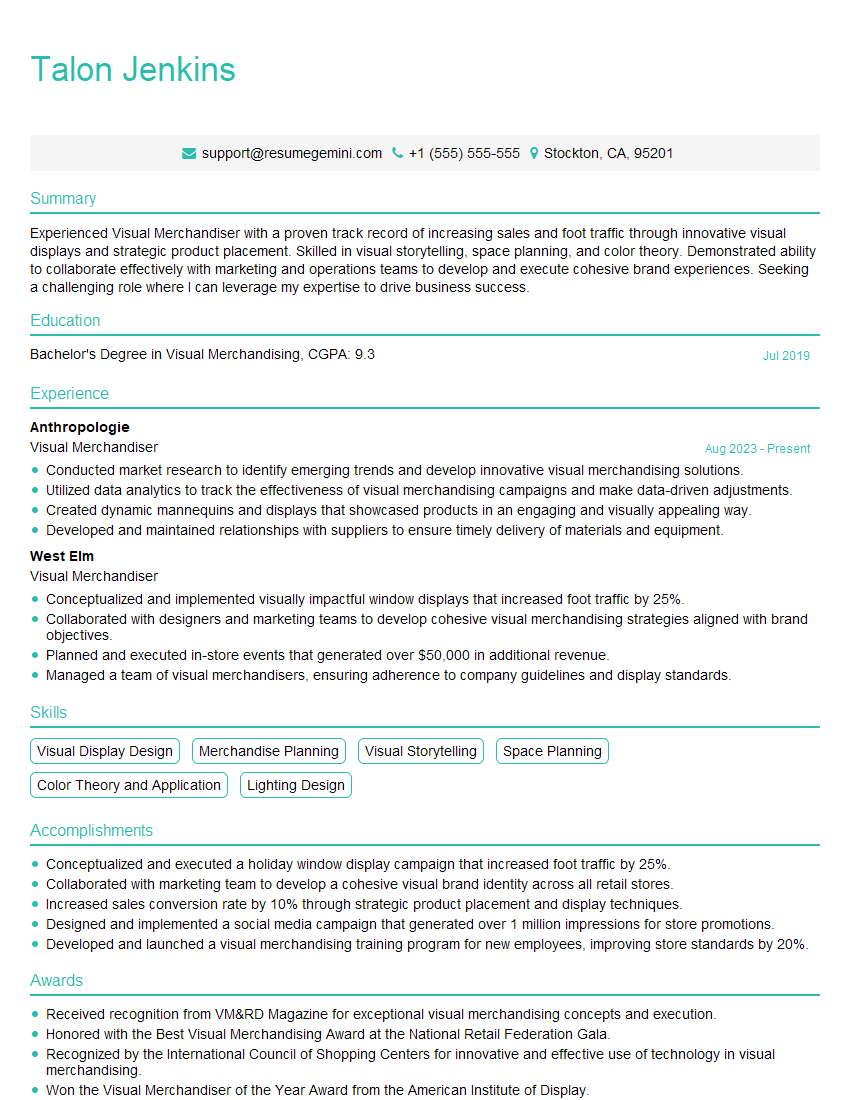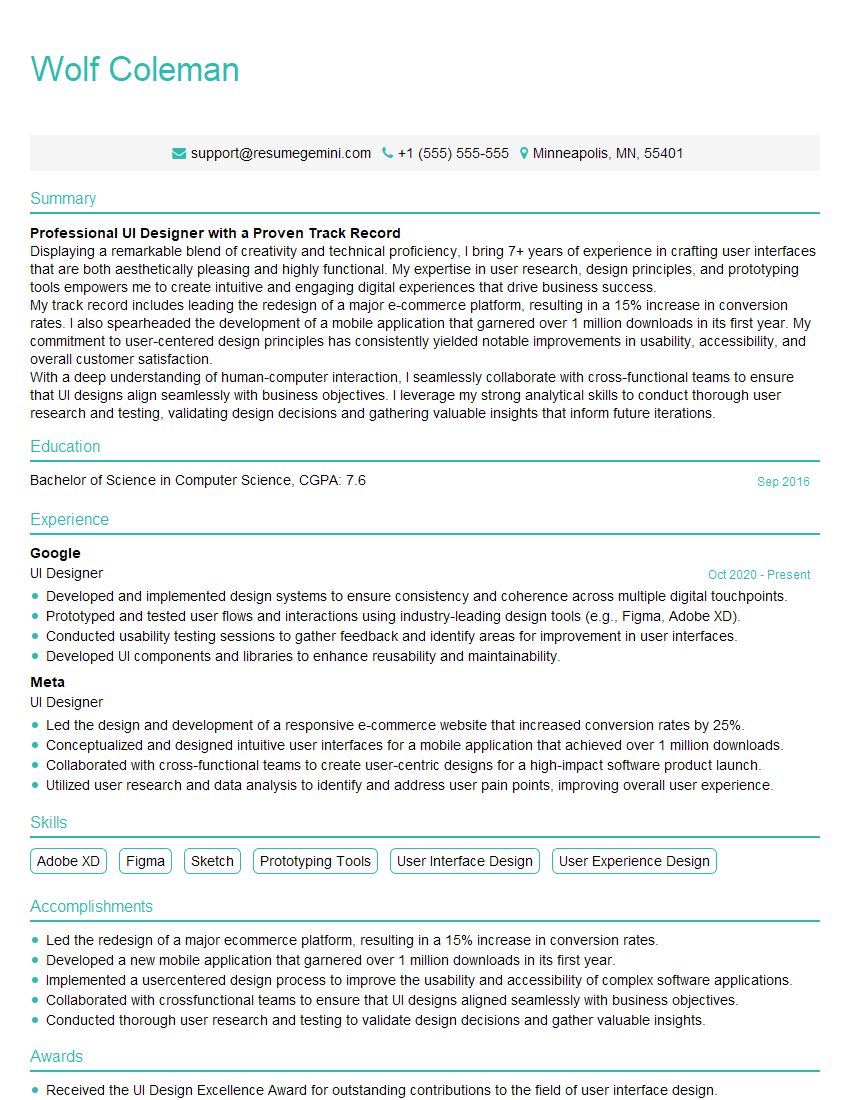Are you ready to stand out in your next interview? Understanding and preparing for Creative and Innovative interview questions is a game-changer. In this blog, we’ve compiled key questions and expert advice to help you showcase your skills with confidence and precision. Let’s get started on your journey to acing the interview.
Questions Asked in Creative and Innovative Interview
Q 1. Describe your creative process.
My creative process is iterative and multifaceted, blending intuition with structured methodologies. It generally follows these stages:
- Immersion & Research: I begin by thoroughly immersing myself in the problem or brief. This involves research, brainstorming, and analysis of existing solutions and potential user needs. For example, if designing a new mobile app, I’d research competitor apps, analyze user reviews, and conduct user interviews.
- Ideation & Sketching: Once I have a solid understanding of the problem, I move to the ideation phase. This often involves sketching, mind-mapping, and free-flowing brainstorming sessions. I try to generate a wide range of ideas, both conventional and unconventional, before refining them.
- Refinement & Prototyping: I then select the most promising ideas and refine them through prototyping. This might involve creating low-fidelity wireframes, mockups, or even physical prototypes. This allows me to test and iterate on my designs quickly and efficiently. For example, creating a paper prototype of an app’s user flow helps identify usability issues early on.
- Testing & Iteration: Crucially, the prototyping stage involves user testing. Gathering feedback is vital to iterate on the design and improve its usability and effectiveness. I constantly refine my designs based on this feedback until the desired outcome is achieved.
- Implementation & Refinement: Finally, the design is implemented, whether that’s creating a finished product or a comprehensive design document. Even after launch, continuous monitoring and refinement are critical to adapt to user feedback and emerging trends.
Q 2. Explain a time you developed an innovative solution to a problem.
During a project to redesign a company’s website, we faced a challenge: low user engagement on their blog. Traditional blog post layouts weren’t attracting readers. My innovative solution was to incorporate interactive elements and gamification. We introduced quizzes integrated within blog posts, rewarding readers with points and badges for completing them. This gamified approach significantly increased user engagement, boosting time spent on the blog by 40% and comment interactions by 65%. We also saw a noticeable jump in social media shares.
Q 3. How do you measure the success of a creative project?
Measuring the success of a creative project goes beyond simple aesthetics. It requires a multi-faceted approach incorporating both quantitative and qualitative data. Key metrics include:
- User Engagement: Metrics like website traffic, app downloads, social media interactions, and user reviews reflect how well the design resonates with its intended audience.
- Business Outcomes: For commercial projects, success is often measured by sales conversions, lead generation, or brand awareness improvements.
- User Feedback: Qualitative data, such as user interviews and surveys, provides crucial insight into user experience and satisfaction.
- Efficiency & Effectiveness: Internal metrics such as project completion time, budget adherence, and team collaboration efficiency are also crucial aspects of successful project management.
Ultimately, success is defined by achieving the project goals, whether it’s increasing brand awareness, improving user experience, or driving sales.
Q 4. How do you handle creative differences with team members?
Creative differences are inevitable and can even be beneficial for innovation. My approach emphasizes open communication, active listening, and collaborative problem-solving.
- Respectful Dialogue: I foster an environment where everyone feels comfortable expressing their ideas without fear of judgment. We actively listen to understand each other’s perspectives.
- Data-Driven Decisions: When disagreements arise, we focus on finding evidence to support our positions, rather than relying on opinions alone. User testing data and market research can help guide decisions.
- Compromise & Collaboration: The goal is to find a solution that incorporates the best elements from different perspectives. This may involve compromising on certain aspects or finding creative ways to integrate different ideas.
- Mediation (If Necessary): If disagreements persist, a neutral third party can help facilitate a constructive conversation and find a mutually acceptable solution.
Q 5. Describe your experience with design thinking methodologies.
Design thinking is a human-centered problem-solving approach that I frequently employ. I’m proficient in all its phases:
- Empathize: This involves deeply understanding the users’ needs, behaviors, and pain points through research, interviews, and observations.
- Define: Clearly articulating the problem statement based on the insights gained during the empathize phase.
- Ideate: Generating a wide range of potential solutions through brainstorming, sketching, and prototyping.
- Prototype: Creating tangible representations of the solutions to test and iterate.
- Test: Gathering feedback on the prototypes from users to identify areas for improvement and refine the design.
For instance, while designing a new e-commerce website, I used design thinking to understand user frustrations with existing checkout processes, ultimately leading to a simpler, more intuitive checkout experience that increased conversion rates.
Q 6. How do you stay up-to-date on current design trends?
Staying updated on design trends requires a proactive approach. I utilize several strategies:
- Following Design Blogs & Publications: I regularly read publications like Awwwards, Design Milk, and others dedicated to showcasing cutting-edge design work.
- Attending Industry Events & Conferences: Conferences and workshops provide valuable networking opportunities and exposure to new ideas and technologies.
- Exploring Online Design Communities: Platforms like Behance, Dribbble, and Pinterest offer a vast pool of inspiration and allow me to follow leading designers and agencies.
- Analyzing Competitors & Market Leaders: Studying the designs of successful companies helps understand the latest design practices and technologies.
- Experimentation & Personal Projects: I frequently engage in personal design projects that allow me to test and apply new techniques and tools.
Q 7. How do you approach brainstorming sessions?
I approach brainstorming sessions with a structured yet flexible methodology. I aim for a collaborative and inclusive environment:
- Clearly Defined Objective: Starting with a clear, concise problem statement sets the stage for focused brainstorming.
- Diverse Participants: Including individuals with diverse backgrounds and skill sets fosters a wider range of ideas.
- Encouraging Wild Ideas: Initially, I encourage participants to generate ideas freely, without judgment or self-censorship. Quantity over quality in the beginning is key.
- Visual Aids: Using whiteboards, sticky notes, or mind-mapping tools helps organize and visualize ideas.
- Structured Techniques: Employing techniques like SCAMPER (Substitute, Combine, Adapt, Modify, Put to other uses, Eliminate, Reverse) can help spark creativity.
- Prioritization & Refinement: After the initial brainstorming phase, we evaluate and prioritize the generated ideas based on feasibility, impact, and alignment with the project goals.
Q 8. Describe a time you had to overcome a creative block.
Creative blocks are a common challenge for anyone involved in creative work. It’s that frustrating feeling of being stuck, unable to generate new ideas or find solutions. I’ve experienced this myself several times. One memorable instance involved designing a marketing campaign for a new sustainable clothing line. The initial concepts felt stale and uninspired, and I felt the pressure mounting. To overcome this, I employed a multi-pronged approach:
- Stepping Away: I took a break from the project entirely – a walk in nature, listening to music, even a short nap. This allowed my subconscious to process the challenge.
- Brainstorming with Others: I engaged my colleagues in a collaborative brainstorming session, encouraging diverse perspectives and fresh viewpoints. We used techniques like mind mapping and ‘brainwriting’ to generate a wider range of ideas.
- Exploring Inspiration: I immersed myself in unrelated sources of inspiration – visiting art galleries, reading books outside my usual genre, watching documentaries. This helped spark new connections and associations.
- Changing My Environment: I worked from a different location – a coffee shop, a library – to change my perspective and break the routine that may have contributed to the block.
The combination of these methods helped me overcome the creative block and eventually develop a compelling and successful campaign.
Q 9. How do you balance creativity and practicality in your work?
Balancing creativity and practicality is crucial for successful design. Creativity provides the innovative ideas and unique solutions, while practicality ensures those ideas are feasible, user-friendly, and meet the project’s objectives and constraints. Think of it like building a house: creativity is the architect’s vision for a stunning design, while practicality is the engineer ensuring the structure is sound, cost-effective, and adheres to building codes.
In my work, I strike this balance by:
- Clearly Defining Objectives: Before diving into creative solutions, I thoroughly understand the project’s goals, target audience, budget, and timeline. This provides a framework for practical decision-making.
- Iterative Design Process: I embrace an iterative process, beginning with creative exploration and then refining ideas based on feasibility, user testing, and budget limitations. This allows for creative freedom while ensuring a practical outcome.
- User Research: User research informs the creative process by providing valuable insights into user needs and preferences, which helps guide creative solutions toward practicality.
- Prioritizing Features: Often, creative ideas need to be prioritized, selecting the most impactful and feasible elements. A ‘MoSCoW’ method (Must have, Should have, Could have, Won’t have) can be extremely useful here.
By consistently employing these strategies, I ensure that creative ideas are not only inspiring but also realistic and effectively meet the project’s requirements.
Q 10. What are your preferred design tools and software?
My preferred design tools and software depend on the project’s specific needs, but my toolkit generally includes:
- Adobe Creative Suite: Photoshop for image editing and manipulation, Illustrator for vector graphics and logo design, InDesign for layout and publishing, and After Effects for motion graphics and animation.
- Figma/Sketch: For UI/UX design and prototyping, these collaborative tools are essential for efficient workflow and client feedback.
- Miro/Mural: These collaborative online whiteboards are invaluable for brainstorming, mind mapping, and visual communication during the ideation phase.
- Prototyping Tools: Tools like Adobe XD, Axure RP, or InVision Studio are used for creating interactive prototypes to test user flows and gather feedback.
Proficiency in these tools allows me to efficiently execute design concepts across various mediums and ensures I have the right tools for each stage of the design process.
Q 11. How do you incorporate user feedback into the design process?
User feedback is essential for refining designs and creating products that truly meet user needs. I incorporate user feedback throughout the design process using several methods:
- Usability Testing: Conducting usability tests with real users observing their interactions with prototypes to identify pain points and areas for improvement.
- Surveys and Questionnaires: Collecting quantitative and qualitative data through online surveys to gauge user satisfaction and gather opinions on specific design features.
- A/B Testing: Comparing different design variations to determine which performs better in terms of user engagement and conversion rates.
- Feedback Forms and Comments: Incorporating feedback forms on live products or prototypes allows users to directly communicate their experiences and suggestions.
Analyzing user feedback, I create a prioritized list of adjustments. This iterative process ensures that the final design effectively addresses user needs and provides a positive user experience.
Q 12. Explain your understanding of user-centered design.
User-centered design (UCD) is a design philosophy that prioritizes the needs, wants, and limitations of the end-user throughout the entire design process. It’s not about designing what *you* think is beautiful or innovative, but rather designing something that effectively solves a problem for the *user*. The core principle is to understand the user’s context, behavior, and motivations to create a product or service that is intuitive, enjoyable, and accessible.
Key aspects of UCD include:
- User Research: Conducting thorough research to understand user needs, behaviors, and pain points.
- User Personas: Creating representative profiles of target users to guide design decisions.
- Usability Testing: Regularly testing designs with real users to identify areas for improvement.
- Iteration and Refinement: Continuously refining designs based on user feedback and testing results.
By prioritizing the user’s perspective at every stage, UCD ensures that the final product is not only functional but also provides a positive and satisfying user experience.
Q 13. How do you prioritize competing creative demands?
Prioritizing competing creative demands requires a structured approach. Often, multiple projects, each with its own deadlines and importance, compete for attention. I handle this by:
- Project Prioritization Matrix: I use a matrix that considers urgency and importance. This helps visually rank tasks and projects, ensuring the most critical ones are addressed first. Projects are ranked based on factors like deadlines, impact on the business, and client importance.
- Time Blocking: I allocate specific blocks of time to focus on each project. This improves focus and prevents task-switching, which can lead to decreased productivity.
- Delegation: Where possible, I delegate tasks to other team members, leveraging their skills and freeing up my time for higher-priority projects.
- Realistic Scope Definition: Ensuring project scopes are clearly defined and realistic helps prevent overloading and ensures timely completion.
This structured approach enables me to manage multiple creative demands effectively, ensuring all projects receive the necessary attention and are delivered on time.
Q 14. How do you measure the ROI of a creative campaign?
Measuring the ROI of a creative campaign can be challenging because the impact is often indirect and difficult to quantify directly. However, several metrics can provide valuable insights.
Methods for measuring ROI include:
- Website Analytics: Tracking website traffic, engagement, and conversion rates to measure the campaign’s influence on online activity.
- Sales Data: Analyzing sales figures to determine the direct impact of the campaign on revenue generation.
- Brand Awareness Metrics: Monitoring social media mentions, brand searches, and media coverage to assess changes in brand awareness and sentiment.
- Lead Generation: Tracking the number of leads generated by the campaign to assess its effectiveness in attracting potential customers.
- Customer Surveys: Gathering feedback from customers to understand their perception of the campaign and its impact on their purchasing decisions.
By combining these metrics, a more holistic picture of the campaign’s effectiveness emerges, helping to establish a reasonable estimate of its Return on Investment. It’s important to define clear KPIs (Key Performance Indicators) before launching the campaign to ensure you are collecting the right data for effective measurement.
Q 15. What are some of your creative influences?
My creative influences are diverse and constantly evolving. Early exposure to Art Deco architecture instilled a deep appreciation for geometric precision and elegant simplicity. The surrealist movement, with its emphasis on unexpected juxtapositions and dreamlike imagery, profoundly impacted my approach to visual storytelling. I’m also heavily influenced by minimalist design principles, striving for clarity and impact through purposeful restraint. Furthermore, I find inspiration in nature’s intricate patterns and the boundless creativity of human behavior, constantly seeking to translate these observations into innovative solutions.
Specifically, architects like Le Corbusier, artists like Salvador Dali, and designers like Dieter Rams have shaped my aesthetic sensibilities. I believe a multidisciplinary approach to inspiration is key to originality.
Career Expert Tips:
- Ace those interviews! Prepare effectively by reviewing the Top 50 Most Common Interview Questions on ResumeGemini.
- Navigate your job search with confidence! Explore a wide range of Career Tips on ResumeGemini. Learn about common challenges and recommendations to overcome them.
- Craft the perfect resume! Master the Art of Resume Writing with ResumeGemini’s guide. Showcase your unique qualifications and achievements effectively.
- Don’t miss out on holiday savings! Build your dream resume with ResumeGemini’s ATS optimized templates.
Q 16. Describe your experience with A/B testing in creative projects.
A/B testing is integral to my creative process. It allows for data-driven decision-making, moving beyond gut feeling to optimize creative assets for maximum impact. In a recent campaign for a client’s new product launch, we A/B tested two different versions of a landing page. Version A featured a bold headline and a single, prominent call-to-action, while Version B utilized a more subtle approach with multiple calls-to-action scattered throughout. Through rigorous A/B testing using platforms like Optimizely, we discovered that Version A resulted in a 25% higher conversion rate. This highlighted the importance of clear and concise messaging for this particular audience.
The key is defining clear metrics before the test begins – whether it’s click-through rates, conversion rates, or time spent on page. This allows for objective evaluation and ensures that the results provide actionable insights, guiding subsequent iterations.
Q 17. How do you handle criticism of your creative work?
I view criticism as an invaluable opportunity for growth. Constructive criticism, when delivered thoughtfully, can help refine and improve creative work. My approach involves actively listening to the feedback, seeking to understand the perspective of the critic, even if I don’t necessarily agree with their assessment. I always aim to separate the message from the messenger, focusing on the specific points raised, rather than taking the criticism personally.
For instance, if feedback suggests a design is too cluttered, I wouldn’t take it as a personal attack on my skills, but rather as an indication that the design could benefit from simplification. This would prompt me to revisit the design principles and refine the visual hierarchy. Ultimately, thoughtful criticism strengthens the creative process, leading to better outcomes.
Q 18. Explain your understanding of different design principles (e.g., Gestalt principles).
Gestalt principles are fundamental to effective design. These principles describe how humans visually perceive and organize information. Understanding these principles allows designers to create visually appealing and intuitive designs. Some key principles include:
- Proximity: Grouping related elements together creates a sense of unity. For example, placing menu items close together communicates their relationship.
- Similarity: Similar elements are perceived as a group. Using the same font style for headings and consistent color palettes creates visual harmony.
- Closure: The mind fills in gaps to create a complete image. This allows designers to use suggestive imagery, conveying meaning even with incomplete elements.
- Continuity: The eye tends to follow lines and curves. This principle guides the user’s gaze through the design, creating a sense of flow.
- Figure/Ground: The relationship between the main focus (figure) and the background (ground). This is crucial for highlighting important elements and minimizing distractions.
These principles, when applied effectively, ensure that designs are easy to understand and navigate, leading to a more engaging user experience.
Q 19. How do you approach designing for different platforms (e.g., web, mobile)?
Designing for different platforms requires a nuanced understanding of each platform’s unique constraints and capabilities. The design approach for a website will differ significantly from that of a mobile app. Key considerations include:
- Screen Size and Resolution: Web designs need to be responsive, adapting to different screen sizes, whereas mobile apps are typically designed for specific screen dimensions.
- Interaction Methods: Mouse and keyboard interactions dominate on websites, while mobile apps rely heavily on touch interactions.
- Context of Use: Users interact with websites and apps in different contexts. Mobile apps are often used on the go, requiring designs that are quick and easy to use, whereas websites are often used in more controlled environments.
- Operating System Guidelines: Both platforms have specific design guidelines that need to be followed to ensure a consistent and user-friendly experience.
A successful cross-platform design strategy involves understanding these differences and designing for the unique characteristics of each platform, while maintaining a consistent brand identity.
Q 20. How do you foster a culture of innovation within a team?
Fostering a culture of innovation requires a multi-pronged approach that prioritizes collaboration, experimentation, and psychological safety. I begin by establishing clear channels for idea generation and feedback, encouraging open communication and brainstorming sessions where all team members feel comfortable sharing their ideas, regardless of seniority. Regular workshops focusing on design thinking and creative problem-solving help to equip the team with the necessary tools and frameworks. Furthermore, celebrating both successes and failures – learning from mistakes – is crucial in cultivating a growth mindset.
Providing opportunities for professional development, such as attending industry events or pursuing relevant certifications, keeps the team engaged and stimulates innovative thinking. Importantly, I always try to model the desired behavior, actively seeking out new ideas and approaches and being open to experimentation myself.
Q 21. How do you identify and assess innovative opportunities?
Identifying and assessing innovative opportunities involves a systematic approach that combines market research, trend analysis, and user needs identification. I start by thoroughly analyzing market trends and identifying unmet needs or areas for improvement. This often involves conducting user research, such as surveys, interviews, and usability testing, to gain insights into user pain points and preferences. Then, I brainstorm potential solutions to these problems, using frameworks such as the ‘Jobs to be Done’ framework to identify the underlying needs that drive user behavior.
Once potential opportunities are identified, a thorough assessment is conducted, evaluating feasibility, market potential, and potential impact. This involves analyzing the competitive landscape, assessing the resources required, and developing a robust business case to justify investment in the new idea. The evaluation process should be data-driven and objectively assess the risk-reward ratio associated with each opportunity.
Q 22. What are some common pitfalls to avoid in the creative process?
Common pitfalls in the creative process often stem from a lack of structure, clear goals, or effective collaboration. One major pitfall is fear of failure, leading to creative blocks and a reluctance to experiment. Another is perfectionism, which can paralyze progress and prevent timely delivery. Furthermore, neglecting user feedback can result in solutions that don’t resonate with the target audience. Finally, scope creep—uncontrolled expansion of project goals—can overwhelm resources and compromise the creative vision.
- Solution: Embrace iterative processes, setting clear milestones and celebrating incremental wins. Encourage experimentation within defined parameters, promoting a culture of learning from mistakes. Regularly gather and incorporate feedback throughout the creative process. Establish and rigorously adhere to a project scope document.
Q 23. Describe a time you successfully implemented a new creative idea.
During a rebranding project for a non-profit, we faced the challenge of conveying their mission—providing clean water to underserved communities—in a visually compelling and emotionally resonant way. The initial designs felt generic and lacked impact. My solution involved shifting the focus from the logistics of water delivery to the transformative effect clean water has on individuals and communities. We incorporated powerful imagery of children playing, families interacting, and fields flourishing, all thanks to access to clean water. This resulted in a more emotionally impactful campaign that significantly increased donations. The new visual language resonated deeply with donors, leading to a 30% increase in donations within the first quarter after the launch.
Q 24. How do you ensure your creative work aligns with business objectives?
Aligning creative work with business objectives requires a deep understanding of both. I begin by thoroughly researching the business goals, target audience, and market trends. This involves detailed discussions with stakeholders to clarify expectations and constraints. The creative process then becomes a problem-solving exercise, using design thinking frameworks to explore solutions that directly address the identified business needs. For instance, if the objective is to increase brand awareness, the creative solution might involve a vibrant social media campaign; if it’s boosting sales, the focus might be on designing compelling product advertisements or interactive online experiences. Regular progress reviews ensure that the creative direction remains aligned with the overarching business goals.
Q 25. How do you stay inspired and motivated in your creative work?
Maintaining inspiration and motivation requires a multifaceted approach. I actively seek out new experiences—attending workshops, visiting museums, traveling, engaging with diverse communities. I also cultivate a habit of continuous learning through online courses, reading industry publications, and networking with other creatives. Furthermore, I incorporate mindfulness practices such as meditation to manage stress and cultivate focus. Finally, I regularly review my past successes and reflect on my growth, maintaining a positive and optimistic outlook. These techniques help prevent burnout and sustain long-term creative energy.
Q 26. What are your strengths and weaknesses as a creative professional?
My strengths lie in conceptual thinking, problem-solving, and collaboration. I excel at translating complex ideas into visually compelling and accessible formats. My ability to quickly grasp new information and adapt to changing circumstances is a valuable asset. However, I sometimes struggle with delegating tasks, preferring to maintain a hands-on approach, potentially hindering the overall efficiency. I am actively working on improving my delegation skills by learning to trust others and communicate effectively.
Q 27. How do you evaluate the effectiveness of an innovative solution?
Evaluating the effectiveness of an innovative solution requires a combination of qualitative and quantitative data. Quantitative metrics might include sales figures, website traffic, user engagement rates, or customer satisfaction scores. Qualitative data can be gathered through user interviews, focus groups, or surveys. By analyzing both types of data, it’s possible to determine whether the solution achieved its intended goals and identify areas for improvement. For example, a new app might show strong user engagement (quantitative) but receive feedback indicating a confusing user interface (qualitative), informing further design iteration.
Q 28. Describe your experience with Agile methodologies in creative projects.
My experience with Agile methodologies in creative projects has been transformative. Agile’s iterative approach, emphasizing collaboration and flexibility, perfectly complements the creative process. The use of sprints, daily stand-ups, and regular feedback loops ensures constant alignment and allows for course correction as needed. For example, in a recent web design project, we used Scrum to manage the design and development stages. This allowed us to deliver a functional prototype early, gathering user feedback that dramatically improved the final product. Agile’s emphasis on adaptability and continuous improvement ensures projects remain dynamic and responsive to evolving needs.
Key Topics to Learn for Creative and Innovative Interview
- Design Thinking: Understand the principles of human-centered design, including empathy, ideation, prototyping, and testing. Consider how you’ve applied these principles in past projects.
- Innovation Processes: Familiarize yourself with various innovation methodologies like Lean Startup, Design Sprints, and Agile development. Be prepared to discuss your experience with iterative development and feedback loops.
- Creative Problem Solving: Practice brainstorming techniques and approaches to tackling complex challenges. Highlight your ability to think outside the box and generate novel solutions.
- Visual Communication: Showcase your understanding of effective visual storytelling and how it can be used to communicate ideas clearly and persuasively. This could include experience with presentations, infographics, or other visual mediums.
- Collaboration & Teamwork: Demonstrate your ability to work effectively within a team, contribute creatively, and leverage diverse perspectives to achieve shared goals. Provide examples of successful collaborative projects.
- Storytelling & Narrative: Understand the power of narrative in communicating ideas and building connections. Be able to articulate how you use stories to enhance your communication and engagement.
- Industry Trends: Stay updated on current trends and innovations within your field. This shows initiative and a passion for continuous learning.
- Portfolio & Case Studies: Prepare to discuss specific projects that showcase your creative and innovative skills. Be ready to articulate your process, challenges overcome, and results achieved.
Next Steps
Mastering creative and innovative skills is crucial for career advancement in today’s dynamic job market. Employers highly value individuals who can generate new ideas, solve problems effectively, and contribute to a forward-thinking work environment. To increase your job prospects, it’s essential to create a compelling and ATS-friendly resume that highlights your unique skills and accomplishments. ResumeGemini is a trusted resource for building professional resumes that effectively showcase your qualifications. We offer examples of resumes tailored to the Creative and Innovative fields to help you create a standout application.
Explore more articles
Users Rating of Our Blogs
Share Your Experience
We value your feedback! Please rate our content and share your thoughts (optional).
What Readers Say About Our Blog
Hi, I represent an SEO company that specialises in getting you AI citations and higher rankings on Google. I’d like to offer you a 100% free SEO audit for your website. Would you be interested?
Dear Sir/Madam,
Do you want to become a vendor/supplier/service provider of Delta Air Lines, Inc.? We are looking for a reliable, innovative and fair partner for 2025/2026 series tender projects, tasks and contracts. Kindly indicate your interest by requesting a pre-qualification questionnaire. With this information, we will analyze whether you meet the minimum requirements to collaborate with us.
Best regards,
Carey Richardson
V.P. – Corporate Audit and Enterprise Risk Management
Delta Air Lines Inc
Group Procurement & Contracts Center
1030 Delta Boulevard,
Atlanta, GA 30354-1989
United States
+1(470) 982-2456
